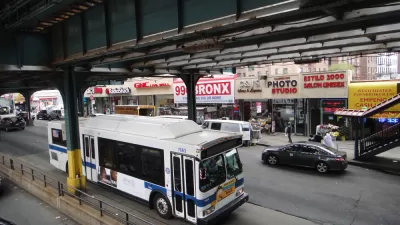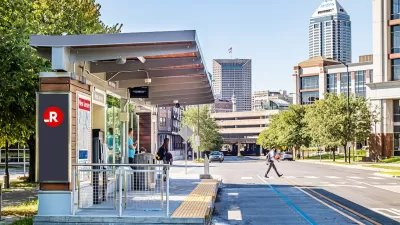What's good for the Bronx turns out to be good for upstate NY. In this case, a Plattsburgh bus manufacturer has received the first orders for what is promoted as the "bus of the future of NYC transit": 3-doors, articulated, low-floor, & low emission.
The first of 90 new articulated buses arrived in the Bronx. They will be a major addition to the city's bus fleet as they will run on bus rapid transit routes, and they also will provide a huge economic stimulus for one upstate community.
"The Nova Bus LFS, which debuted in mid-January along the Bx12, is being called the bus of the future by New York City Transit. These new buses will run along the city's Select Bus Service corridors and these buses were designed with an eye toward speeding up bus service.
Now if only the city would propose those physically-separated bus lanes."
From MTA: NYC Transit Introduces New Articulated Bus into SBS service:
"Combined with off-board fare collection and the bus-only lanes developed and enforced in cooperation with City DOT and the NYPD, travel time is significantly reduced over the regular Bx12 crosstown service."
From SAS: Transit selects upstate company for new buses:
" Transit proponents (have) argued that the entire state would benefit from a healthy MTA, and today's news out of Plattsburgh, NY, a small city on Lake Champlain approximately 30 minutes from Canada, shows why...Nova Bus, a Quebec-based subsidiary of Volvo, has recently opened a plant in Plattsburgh, and that plant will produce these 90 buses."
Thanks to Streetsblog Daily
FULL STORY: New BRT-focused bus debuts in the Bronx

Manufactured Crisis: Losing the Nation’s Largest Source of Unsubsidized Affordable Housing
Manufactured housing communities have long been an affordable housing option for millions of people living in the U.S., but that affordability is disappearing rapidly. How did we get here?

Americans May Be Stuck — But Why?
Americans are moving a lot less than they once did, and that is a problem. While Yoni Applebaum, in his highly-publicized article Stuck, gets the reasons badly wrong, it's still important to ask: why are we moving so much less than before?

Using Old Oil and Gas Wells for Green Energy Storage
Penn State researchers have found that repurposing abandoned oil and gas wells for geothermal-assisted compressed-air energy storage can boost efficiency, reduce environmental risks, and support clean energy and job transitions.

Greening Oakland’s School Grounds
With help from community partners like the Trust for Public Land, Oakland Unified School District is turning barren, asphalt-covered schoolyards into vibrant, green spaces that support outdoor learning, play, and student well-being.

California Governor Suspends CEQA Reviews for Utilities in Fire Areas
Utility restoration efforts in areas affected by the January wildfires in Los Angeles will be exempt from environmental regulations to speed up the rebuilding of essential infrastructure.

Native American Communities Prepare to Lead on Environmental Stewardship
In the face of federal threats to public lands and conservation efforts, indigenous groups continue to model nature-centered conservation efforts.
Urban Design for Planners 1: Software Tools
This six-course series explores essential urban design concepts using open source software and equips planners with the tools they need to participate fully in the urban design process.
Planning for Universal Design
Learn the tools for implementing Universal Design in planning regulations.
Heyer Gruel & Associates PA
City of Moreno Valley
Institute for Housing and Urban Development Studies (IHS)
City of Grandview
Harvard GSD Executive Education
Salt Lake City
NYU Wagner Graduate School of Public Service
City of Cambridge, Maryland




























